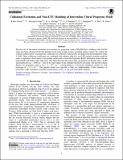Collisional Excitation and Non-LTE Modeling of Interstellar Chiral Propylene Oxide
Author(s)
Dzenis, Karlis; Faure, Alexandre; McGuire, BA; Remijan, AJ; Dagdigian, PJ; Rist, C; Dawes, R; Quintas-Sánchez, E; Lique, F; Hochlaf, M; ... Show more Show less
DownloadPublished version (2.675Mb)
Publisher with Creative Commons License
Publisher with Creative Commons License
Creative Commons Attribution
Terms of use
Metadata
Show full item recordAbstract
The first set of theoretical rotational cross sections for propylene oxide (CH3CHCH2O) colliding with cold He atoms has been obtained at the full quantum level using a high-accuracy potential energy surface. By scaling the collision reduced mass, rotational rate coefficients for collisions with para-H2 are deduced in the temperature range 5–30 K. These collisional coefficients are combined with radiative data in a non-LTE radiative transfer model in order to reproduce observations of propylene oxide made toward the Sagittarius B2(N) molecular cloud with the Green Bank and Parkes radio telescopes. The three detected absorption lines are found to probe the cold (∼10 K) and translucent (nH ∼ 2000 cm−3) gas in the outer edges of the extended Sgr B2(N) envelope. The derived column density for propylene oxide is Ntot ∼ 3 × 1012 cm−2, corresponding to a fractional abundance relative to total hydrogen of ∼2.5 × 10−11. The present results are expected to help our understanding of the chemistry of propylene oxide, including a potential enantiomeric excess, in the cold interstellar medium.
Date issued
2022-02-01Department
Massachusetts Institute of Technology. Department of ChemistryJournal
The Astrophysical Journal
Publisher
American Astronomical Society
Citation
Dzenis, Karlis, Faure, Alexandre, McGuire, BA, Remijan, AJ, Dagdigian, PJ et al. 2022. "Collisional Excitation and Non-LTE Modeling of Interstellar Chiral Propylene Oxide." The Astrophysical Journal, 926 (1).
Version: Final published version